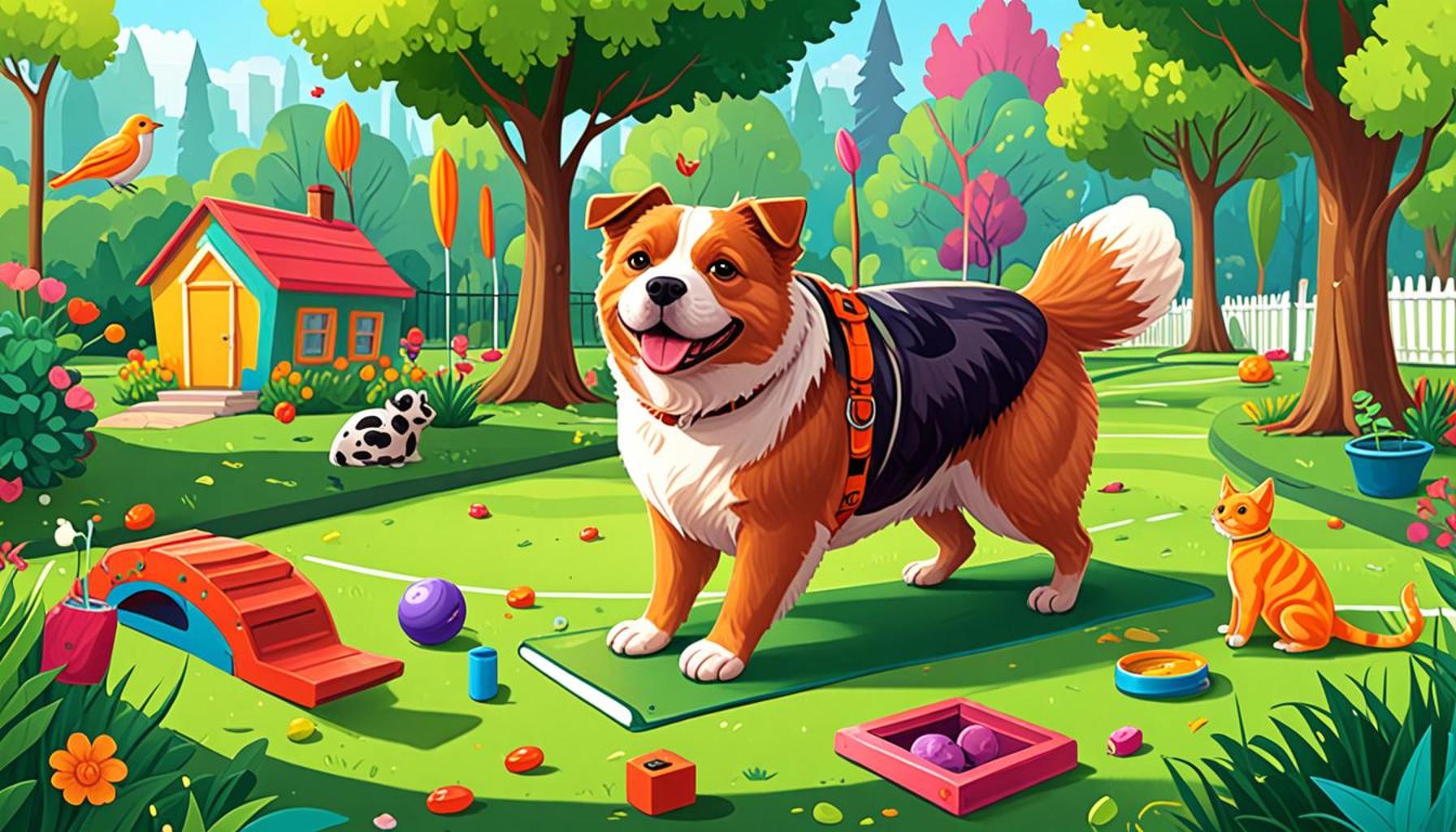Incorporating Play into Training: Engaging Your Pet for Better Learning

The Transformative Role of Play in Pet Training
Training your pet can sometimes feel like a daunting task. However, integrating play into the learning process can transform it into an enjoyable experience for both you and your furry friend. When pets view training as a game, they become more engaged and receptive to learning. This shift in perspective not only makes the training endeavors feel less like chores but can also yield more effective results.
Research shows that pets learn best when they are excited and having fun. Engaging your pet in playful activities creates an environment where learning flourishes. Here are some key benefits of using play during training:
- Increased Motivation: Play keeps your pet eager and willing to participate. For instance, using toys or treats during training can elevate your pet’s enthusiasm, making them more likely to engage in and respond to commands.
- Enhanced Bonding: Engaging in playful activities strengthens the relationship between you and your pet. When you share joyful experiences, such as playful tug-of-war sessions or chasing games, it builds trust and deepens your emotional connection.
- Improved Retention: Fun learning experiences help pets remember commands and behaviors more effectively. A study published in the journal *Animal Cognition* indicated that animals trained through enjoyable interactions exhibited better recall of learned tasks compared to those trained under strict, non-playful conditions.
Different types of play can cater to various learning objectives. Consider these examples:
- Fetch: This classic game not only teaches retrieval skills but also reinforces obedience commands like “drop it” or “come.” It can be an exciting way to practice while allowing your pet to burn off energy.
- Hide and Seek: This can encourage problem-solving and patience. By hiding and calling your pet, you stimulate their natural instinct to explore and find, helping reinforce the bond through teamwork.
- Obstacle Courses: Building agility and confidence can be achieved through fun obstacle courses made from household items. For example, you can use cones, hula hoops, and tunnels, encouraging your pet to navigate the course while learning commands like “jump” or “weave.”
Incorporating play into your training routine is not just a creative approach; it is backed by science. Studies indicate that animals, like humans, thrive in environments that foster social interaction and enjoyment. In fact, animal behaviorists emphasize the importance of creating a stimulating environment for pets, noting significant improvements in behavior and learning efficiency when play is involved.
By understanding how playful training can enhance learning, you can pave the way for a well-behaved, happy pet. So next time you embark on a training session, remember to bring along your creative spirit and a selection of toys to make the experience more rewarding for both you and your furry companion.
DON’T MISS: Click here for essential pet adoption tips
Strategies to Incorporate Play into Training
Incorporating play into your pet’s training doesn’t have to be complicated. In fact, it can be as simple as reimagining traditional training techniques through a more playful lens. Below are some strategic methods for integrating play seamlessly into your training sessions:
- Toy Selection: The type of toy used can significantly affect your pet’s interest. Choose toys that resonate with your pet’s instincts—like squeaky toys for dogs with high prey drives or feather wands that stimulate a cat’s hunting instincts. Having the right toys on hand can lead to quicker engagement during training.
- Time and Setting: Optimize training sessions during periods when your pet has plentiful energy—usually after a walk or play session. A familiar, distraction-free environment can also significantly enhance focus and safety, making it easier for your pet to learn.
- Short Sessions: Keep training sessions brief—10 to 15 minutes is ideal—to match your pet’s attention span. This makes it easier to maintain enthusiasm and allows for multiple, bite-sized learning opportunities, each followed by a fun play engagement to reinforce the experience.
- Incorporate Treats: Use treats as rewards not just for compliance, but as part of the game. Adding a “find the treat” game can heighten excitement while reinforcing command recognition. Hide delicious treats around your training space and encourage your pet to sniff them out as a fun reward for good behavior.
- Friendship and Competition: Engage your pet with a buddy for a fun twist on training that taps into their social instincts. Competing against another pet in a game of fetch or obedience exercises can create an energizing atmosphere. Remember to praise not just your pet but others, fostering a sense of camaraderie.
In addition to these strategies, understanding your pet’s unique learning style is essential. Just like people, pets are motivated by different types of play and rewards. For example, while some dogs may respond well to physical play, others might find more satisfaction in mental challenges. Identifying what excites your pet will help you craft a more individualized training approach.
Moreover, observing your pet during play can unveil critical insights into their personality. A dog that enjoys tug-of-war may appreciate a more dynamic training approach that incorporates similar interactive elements, whereas a cat that loves climbing may benefit from vertical exploration in training. Using these preferences to your advantage can lead to effective learning while keeping them entertained.
As you begin to incorporate these playful techniques into your pet’s training routine, remember that consistency and patience are key. Each session should end on a positive note, ensuring your pet looks forward to the next opportunity for engagement. This practice not only fosters better learning but significantly enhances the bond you share with your pet, resulting in a trusted and obedient companion.
| Play Type | Purpose and Benefits |
|---|---|
| Interactive Toys | Encourages problem-solving and mental stimulation. |
| Agility Training | Improves physical coordination and builds a bond between pet and owner. |
| Fetch Games | Enhances retrieving skills and encourages exercise. |
| Hide and Seek | Boosts sensory skills and tests obedience commands in a fun way. |
Utilizing elements of play in pet training not only enhances the learning experience but also deepens the connection between the trainer and the pet. Implementing interactive toys, for example, can transform the training process into a game that stimulates curiosity, making the pet eager to learn. Agility training acts as an excellent physical outlet and fosters teamwork, ensuring pets know they are not just being commanded but are actively participating in the fun. Additionally, incorporating games like fetch guarantees that pets are not just under exercise but also learning valuable retrieval skills. Lastly, activities such as hide and seek not only sharpen obedience but also enhance the pet’s problem-solving abilities while making training sessions a delightful adventure. These playful methods revive the traditional training model and offer an enriching, engaging alternative for better learning outcomes.
DIVE DEEPER: Click here to uncover more insights
Understanding Your Pet’s Play Style
When it comes to incorporating play into training, understanding your pet’s play style can greatly enhance the effectiveness of your sessions. Each pet reacts differently to various forms of engagement, and knowing what makes your companion tick can lead to better learning outcomes.
Types of Play can be categorized into several distinct styles: interactive play, solo play, and exploratory play. Interactive play, where you engage directly with your pet using toys like balls or laser pointers, stimulates their natural instincts and keeps their excitement levels high. Solo play, on the other hand, involves toys they can entertain themselves with—think puzzle toys or treat dispensers that require problem-solving skills. Exploratory play allows pets to discover their environment, and incorporating elements like agility courses or obstacle challenges can be highly beneficial.
Tailoring Training to Play Styles
Once you have a grasp on your pet’s preferred play style, tailor your training methods accordingly. For instance, if your dog thrives on interactive play, consider using games that require them to work for treats. Training commands can be seamlessly integrated into playful games like fetch, where retrieving the ball can be a fun reward in itself. Introduce commands like “drop it” or “leave it” during these sessions, reinforcing their learning while keeping the atmosphere light and enjoyable.
Conversely, if you notice your cat prefers exploratory play, incorporating activities that mimic their natural hunting behaviors can prove advantageous. For example, hide treats in different locations around the house, encouraging them to search and discover. This not only stimulates their mind but also aids in reinforcing the connection between fun and learning.
Leveraging Technology in Play-Based Training
In today’s digital age, technology can play a vital role in enhancing play-based training. Various smartphone applications exist that can gamify the training process. These apps often feature training challenges, reminders, and even interactive games designed to engage your pet in a stimulating manner. Utilizing devices like automatic treat dispensers can provide rewards precisely when your pet performs a task correctly, marrying play with positive reinforcement and ensuring that learning remains a joyful experience.
Community and Playgroups
Another powerful way to incorporate play into training is through community engagement. Local pet training classes or playgroups can introduce your pet to new friends while providing opportunities for social learning. Interaction with other pets can enhance their social skills and create a stimulating environment conducive to learning. Structured play within these groups can focus on basic commands, obedience, and recall games, fostering both competition and camaraderie—all while ensuring your pet remains engaged.
As you weave these concepts into your training strategy, always keep your pet’s safety and well-being at the forefront. Monitor your pet’s reactions during training sessions to ensure that play remains a positive experience. By continuously adapting your techniques and maintaining an open line of communication with your pet, you can cultivate a relationship built on trust, making the learning process as enjoyable as it is effective.
DON’T MISS: Click here for essential training tips
Conclusion
Incorporating play into training is not merely a charming concept; it’s a transformative approach that enhances the learning experience for pets and their owners alike. By understanding your pet’s unique play style and tailoring your training methods accordingly, you can create an engaging environment that fosters joy and effectively reinforces behavioral learning. Engaging in interactive play, leveraging technology, and utilizing community resources such as playgroups are all essential strategies that amplify the training process, consolidating learning through fun and active participation.
Moreover, it’s crucial to pay attention to your pet’s reactions and adapt your methods to ensure a positive learning atmosphere. A well-timed treat from an automatic dispenser can provide instant gratification, while integrating training commands into games reflects a seamless bond between fun and discipline. As owners, embracing this philosophy not only nurtures a stronger connection with our pets but also empowers them to learn in a relaxed and stimulating context.
Ultimately, the journey of incorporating play into training opens up an avenue for not just better learning outcomes but also an enriched, joyful life alongside your furry companions. Take the plunge into this engaging approach and discover the new heights of connection, trust, and mutual enjoyment in your training sessions. In doing so, you’ll realize that training is not just a series of commands, but a shared adventure that strengthens the bond you cherish with your pet.



